Wheel FORD C MAX 2008 1.G Owner's Manual
[x] Cancel search | Manufacturer: FORD, Model Year: 2008, Model line: C MAX, Model: FORD C MAX 2008 1.GPages: 278, PDF Size: 17.5 MB
Page 107 of 278
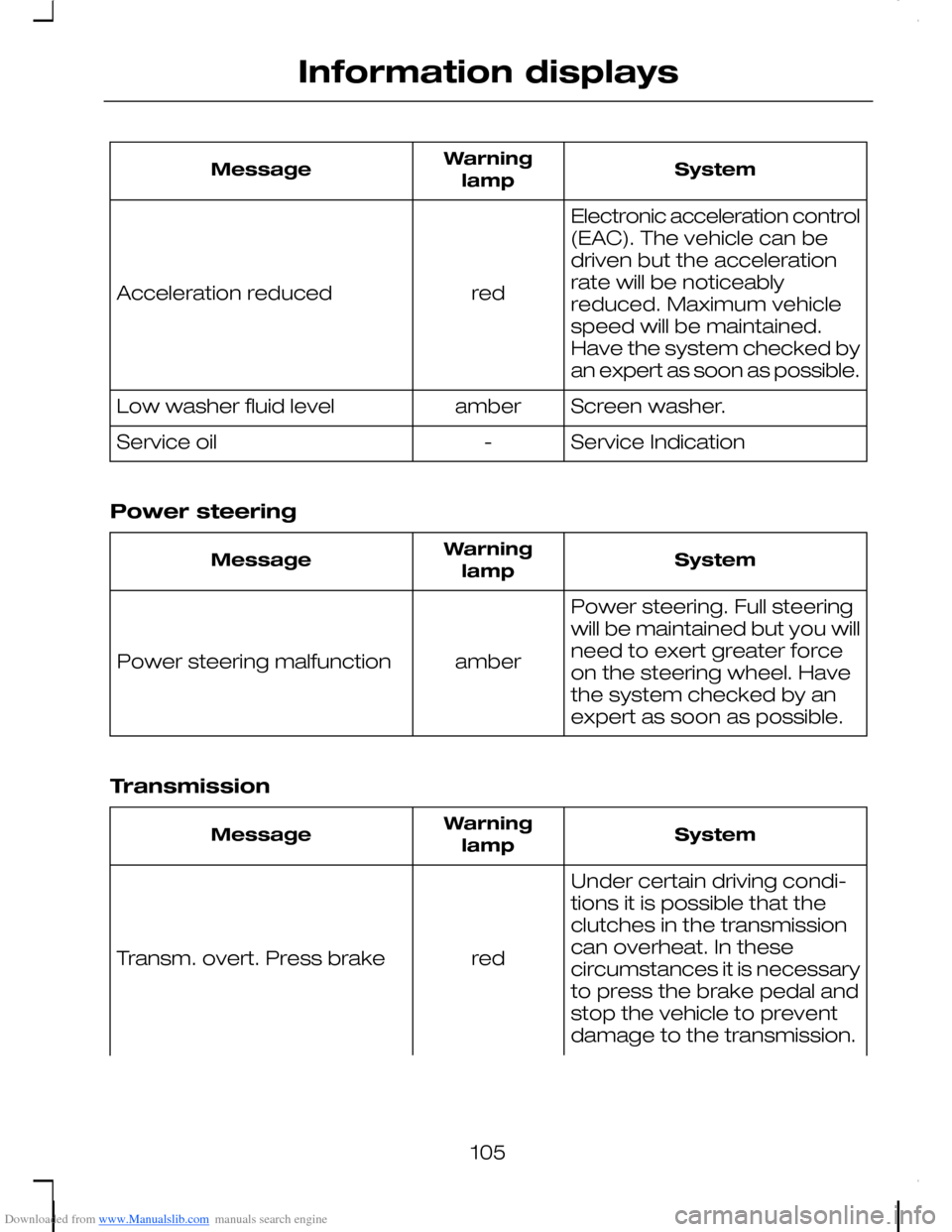
Downloaded from www.Manualslib.com manuals search engine SystemWarninglampMessage
Electronic acceleration control(EAC). The vehicle can bedriven but the accelerationrate will be noticeablyreduced. Maximum vehiclespeed will be maintained.Have the system checked byan expert as soon as possible.
redAcceleration reduced
Screen washer.amberLow washer fluid level
Service Indication-Service oil
Power steering
SystemWarninglampMessage
Power steering. Full steeringwill be maintained but you willneed to exert greater forceon the steering wheel. Havethe system checked by anexpert as soon as possible.
amberPower steering malfunction
Transmission
SystemWarninglampMessage
Under certain driving condi-tions it is possible that theclutches in the transmissioncan overheat. In thesecircumstances it is necessaryto press the brake pedal and
redTransm. overt. Press brake
stop the vehicle to preventdamage to the transmission.
105
Information displays
Page 122 of 278
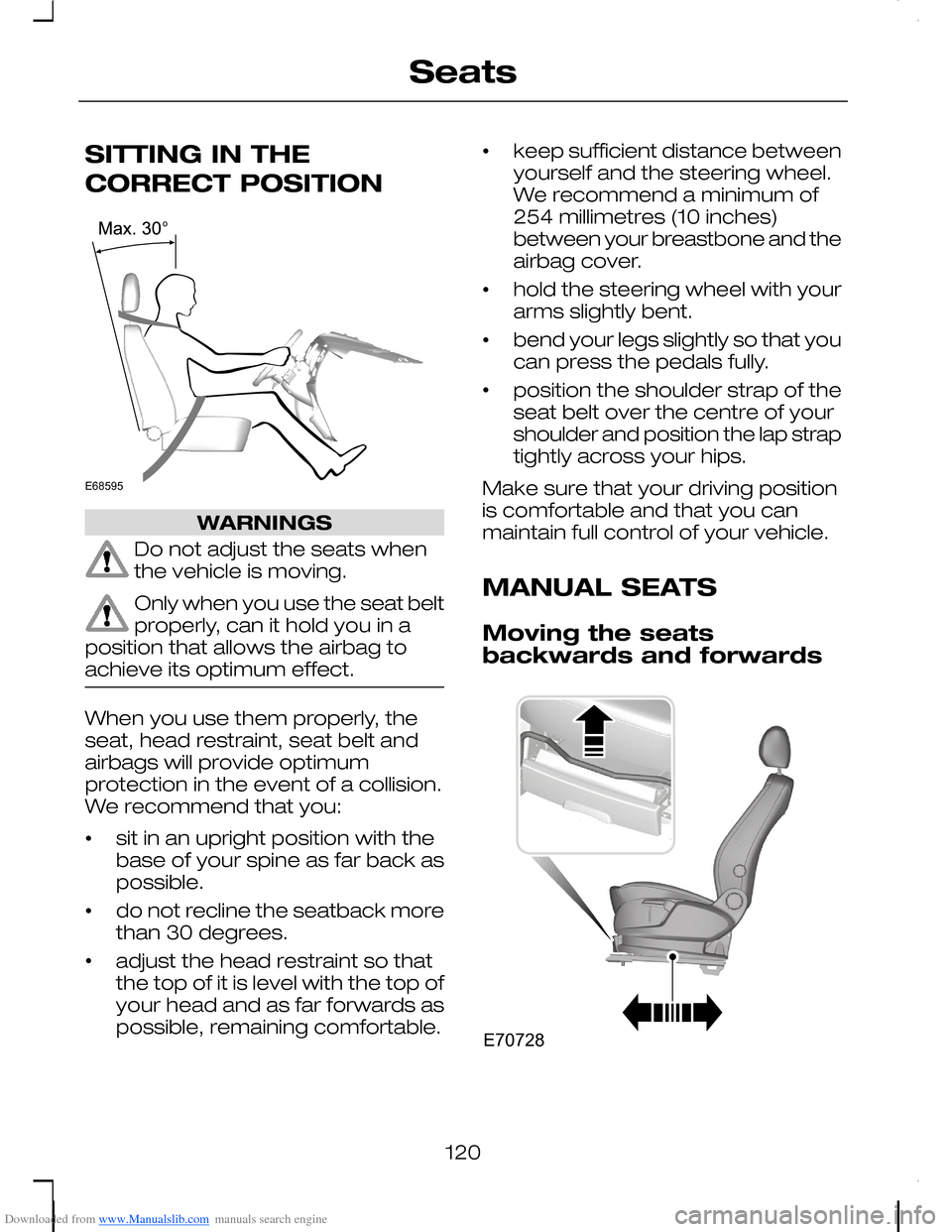
Downloaded from www.Manualslib.com manuals search engine SITTING IN THE
CORRECT POSITION
WARNINGS
Do not adjust the seats whenthe vehicle is moving.
Only when you use the seat beltproperly, can it hold you in aposition that allows the airbag toachieve its optimum effect.
When you use them properly, theseat, head restraint, seat belt andairbags will provide optimumprotection in the event of a collision.We recommend that you:
•sit in an upright position with thebase of your spine as far back aspossible.
•do not recline the seatback morethan 30 degrees.
•adjust the head restraint so thatthe top of it is level with the top ofyour head and as far forwards aspossible, remaining comfortable.
•keep sufficient distance betweenyourself and the steering wheel.We recommend a minimum of254 millimetres (10 inches)between your breastbone and theairbag cover.
•hold the steering wheel with yourarms slightly bent.
•bend your legs slightly so that youcan press the pedals fully.
•position the shoulder strap of theseat belt over the centre of yourshoulder and position the lap straptightly across your hips.
Make sure that your driving positionis comfortable and that you canmaintain full control of your vehicle.
MANUAL SEATS
Moving the seatsbackwards and forwards
120
SeatsE68595 E70728
Page 144 of 278
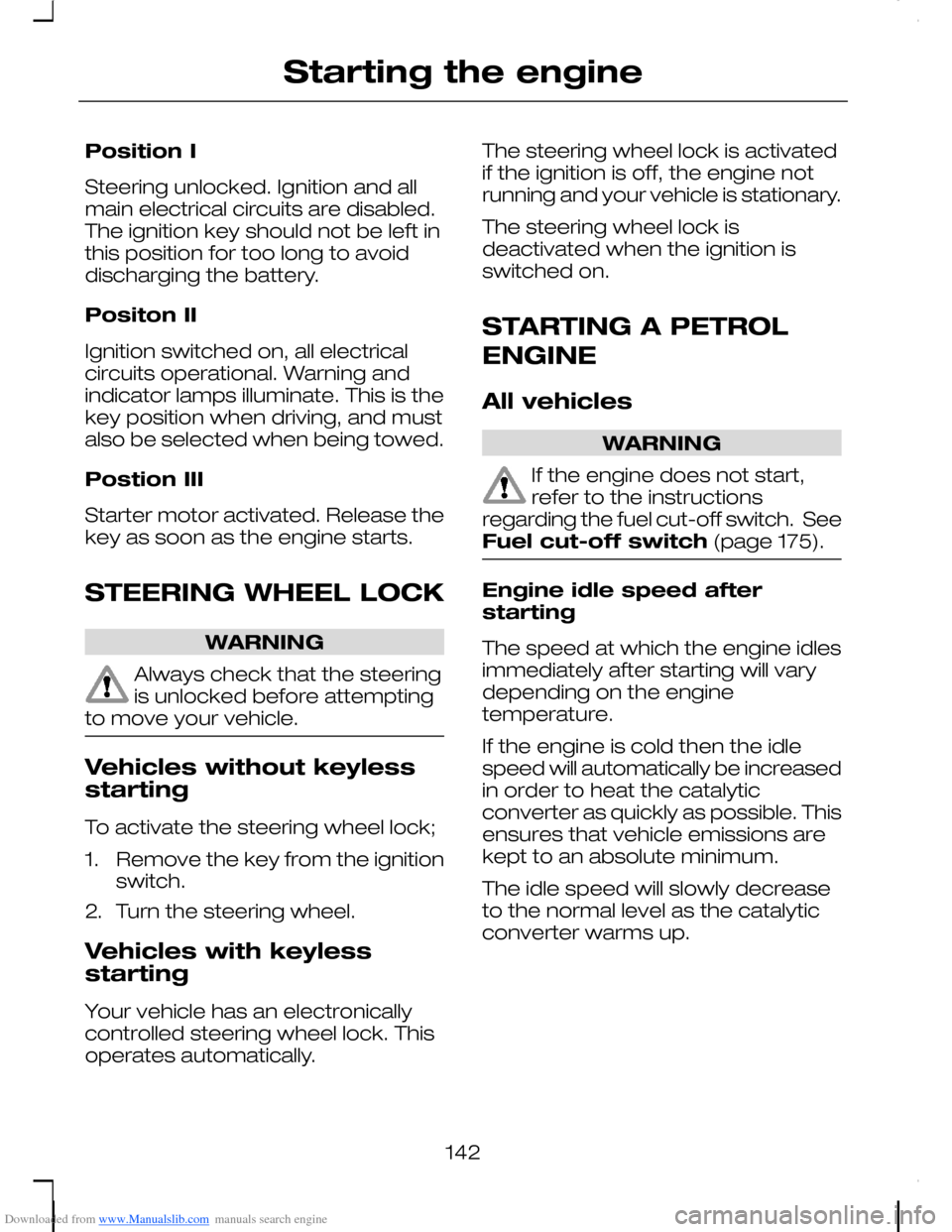
Downloaded from www.Manualslib.com manuals search engine Position I
Steering unlocked. Ignition and allmain electrical circuits are disabled.The ignition key should not be left inthis position for too long to avoiddischarging the battery.
Positon II
Ignition switched on, all electricalcircuits operational. Warning andindicator lamps illuminate. This is thekey position when driving, and mustalso be selected when being towed.
Postion III
Starter motor activated. Release thekey as soon as the engine starts.
STEERING WHEEL LOCK
WARNING
Always check that the steeringis unlocked before attemptingto move your vehicle.
Vehicles without keylessstarting
To activate the steering wheel lock;
1.Remove the key from the ignitionswitch.
2.Turn the steering wheel.
Vehicles with keylessstarting
Your vehicle has an electronicallycontrolled steering wheel lock. Thisoperates automatically.
The steering wheel lock is activatedif the ignition is off, the engine notrunning and your vehicle is stationary.
The steering wheel lock isdeactivated when the ignition isswitched on.
STARTING A PETROL
ENGINE
All vehicles
WARNING
If the engine does not start,refer to the instructionsregarding the fuel cut-off switch. SeeFuel cut-off switch (page 175).
Engine idle speed afterstarting
The speed at which the engine idlesimmediately after starting will varydepending on the enginetemperature.
If the engine is cold then the idlespeed will automatically be increasedin order to heat the catalyticconverter as quickly as possible. Thisensures that vehicle emissions arekept to an absolute minimum.
The idle speed will slowly decreaseto the normal level as the catalyticconverter warms up.
142
Starting the engine
Page 148 of 278
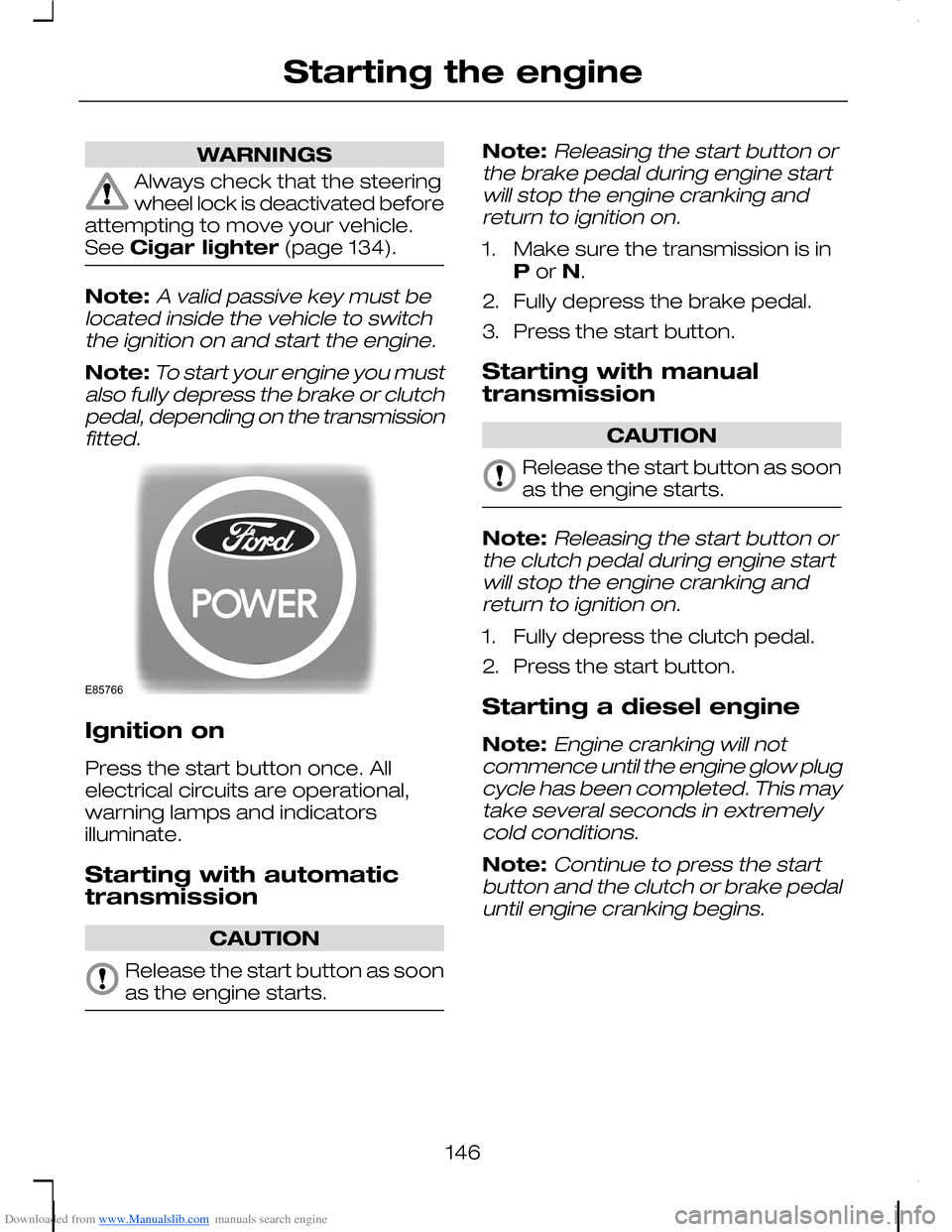
Downloaded from www.Manualslib.com manuals search engine WARNINGS
Always check that the steeringwheel lock is deactivated beforeattempting to move your vehicle.See Cigar lighter (page 134).
Note:A valid passive key must belocated inside the vehicle to switchthe ignition on and start the engine.
Note:To start your engine you mustalso fully depress the brake or clutchpedal, depending on the transmissionfitted.
Ignition on
Press the start button once. Allelectrical circuits are operational,warning lamps and indicatorsilluminate.
Starting with automatictransmission
CAUTION
Release the start button as soonas the engine starts.
Note:Releasing the start button orthe brake pedal during engine startwill stop the engine cranking andreturn to ignition on.
1.Make sure the transmission is inP or N.
2.Fully depress the brake pedal.
3.Press the start button.
Starting with manualtransmission
CAUTION
Release the start button as soonas the engine starts.
Note:Releasing the start button orthe clutch pedal during engine startwill stop the engine cranking andreturn to ignition on.
1.Fully depress the clutch pedal.
2.Press the start button.
Starting a diesel engine
Note:Engine cranking will notcommence until the engine glow plugcycle has been completed. This maytake several seconds in extremelycold conditions.
Note:Continue to press the startbutton and the clutch or brake pedaluntil engine cranking begins.
146
Starting the engineE85766
Page 157 of 278
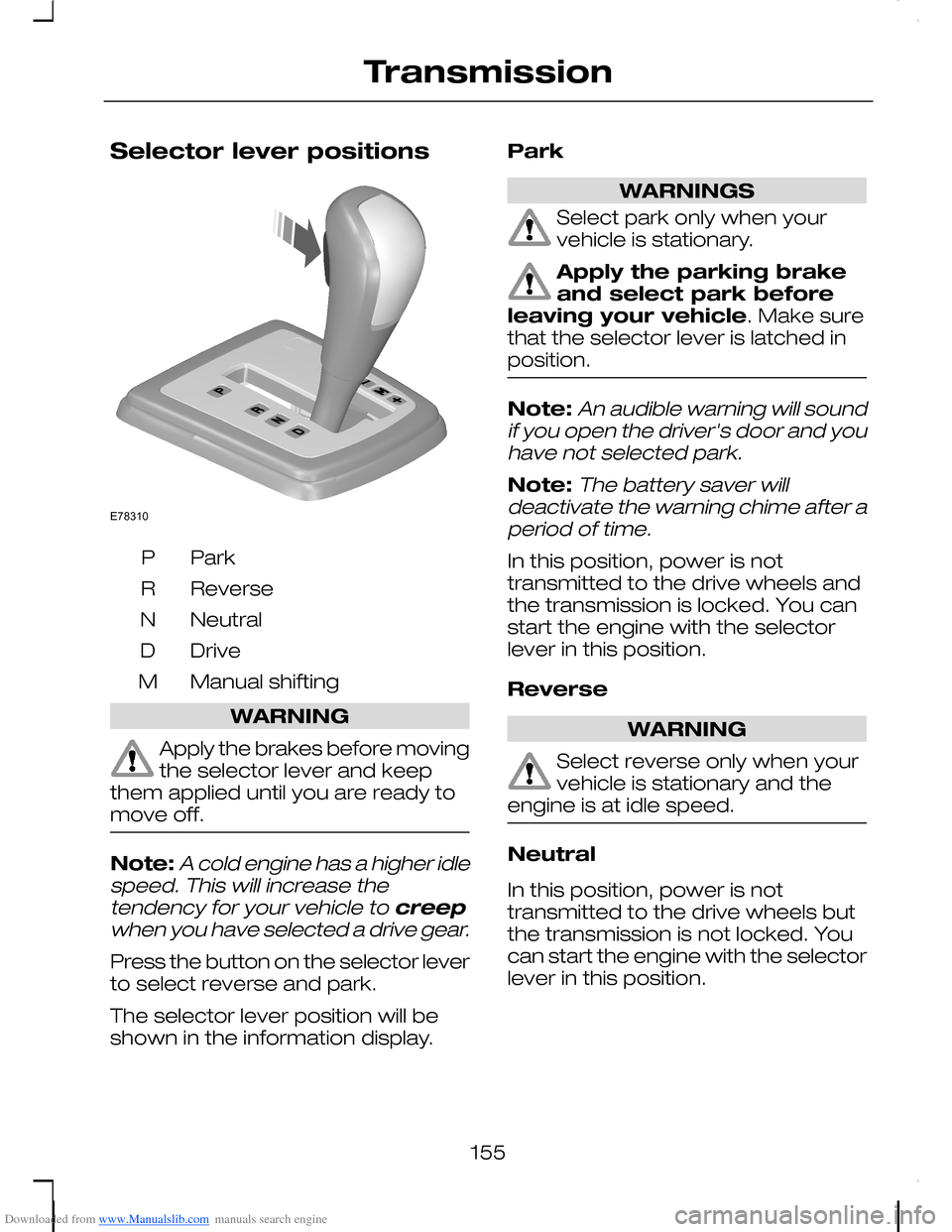
Downloaded from www.Manualslib.com manuals search engine Selector lever positions
ParkP
ReverseR
NeutralN
DriveD
Manual shiftingM
WARNING
Apply the brakes before movingthe selector lever and keepthem applied until you are ready tomove off.
Note:A cold engine has a higher idlespeed. This will increase thetendency for your vehicle to creepwhen you have selected a drive gear.
Press the button on the selector leverto select reverse and park.
The selector lever position will beshown in the information display.
Park
WARNINGS
Select park only when yourvehicle is stationary.
Apply the parking brakeand select park beforeleaving your vehicle. Make surethat the selector lever is latched inposition.
Note:An audible warning will soundif you open the driver's door and youhave not selected park.
Note:The battery saver willdeactivate the warning chime after aperiod of time.
In this position, power is nottransmitted to the drive wheels andthe transmission is locked. You canstart the engine with the selectorlever in this position.
Reverse
WARNING
Select reverse only when yourvehicle is stationary and theengine is at idle speed.
Neutral
In this position, power is nottransmitted to the drive wheels butthe transmission is not locked. Youcan start the engine with the selectorlever in this position.
155
TransmissionE78310
Page 160 of 278
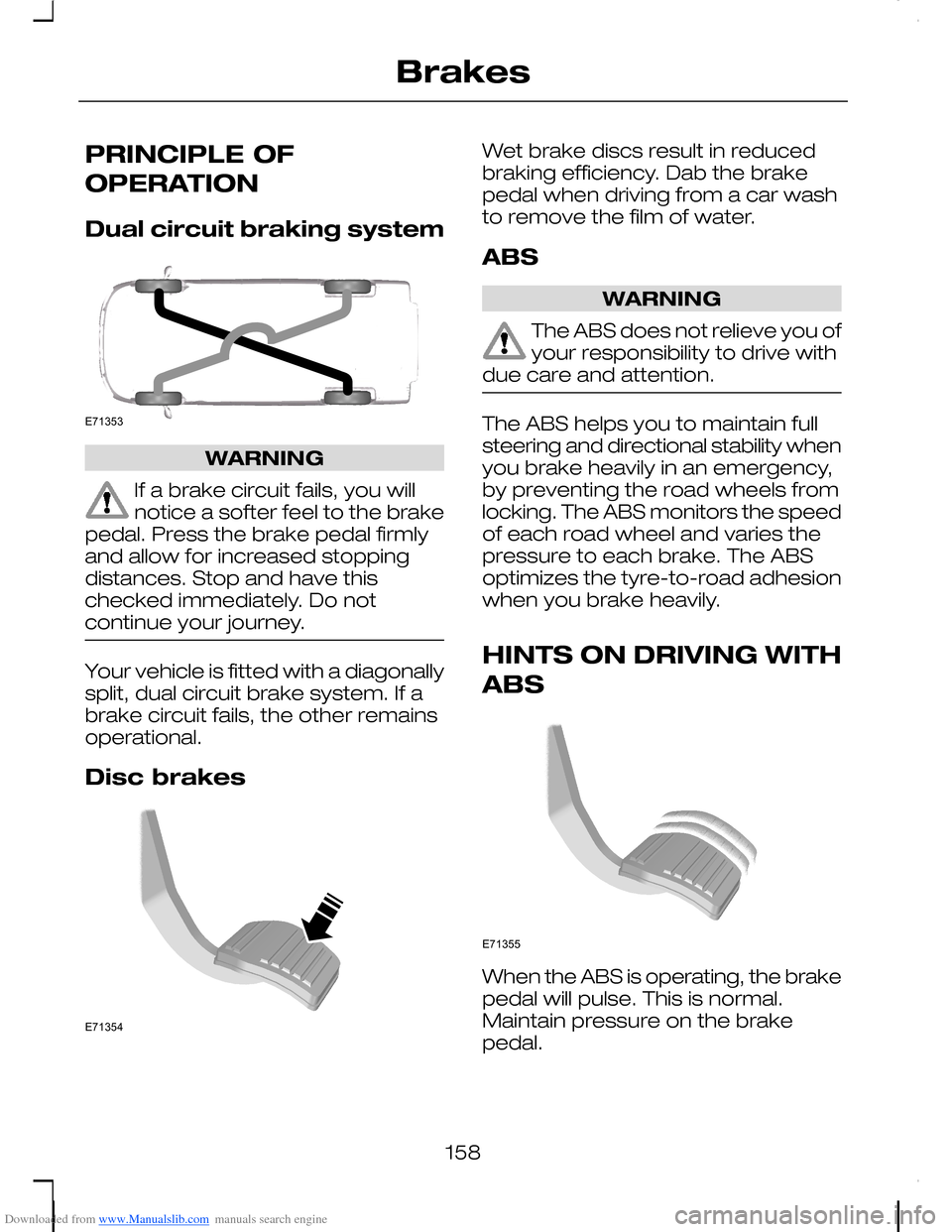
Downloaded from www.Manualslib.com manuals search engine PRINCIPLE OF
OPERATION
Dual circuit braking system
WARNING
If a brake circuit fails, you willnotice a softer feel to the brakepedal. Press the brake pedal firmlyand allow for increased stoppingdistances. Stop and have thischecked immediately. Do notcontinue your journey.
Your vehicle is fitted with a diagonallysplit, dual circuit brake system. If abrake circuit fails, the other remainsoperational.
Disc brakes
Wet brake discs result in reducedbraking efficiency. Dab the brakepedal when driving from a car washto remove the film of water.
ABS
WARNING
The ABS does not relieve you ofyour responsibility to drive withdue care and attention.
The ABS helps you to maintain fullsteering and directional stability whenyou brake heavily in an emergency,by preventing the road wheels fromlocking. The ABS monitors the speedof each road wheel and varies thepressure to each brake. The ABSoptimizes the tyre-to-road adhesionwhen you brake heavily.
HINTS ON DRIVING WITH
ABS
When the ABS is operating, the brakepedal will pulse. This is normal.Maintain pressure on the brakepedal.
158
BrakesE71353 E71354 E71355
Page 161 of 278

Downloaded from www.Manualslib.com manuals search engine The ABS will not eliminate thedangers inherent when:
•you drive too close to the vehiclein front of you.
•the vehicle is aquaplaning.
•you take corners too fast.
•the road surface is poor.
PARKING BRAKE
All vehicles
WARNING
Vehicles with an automatictransmission should always beleft with the selector lever in positionP.
•Press the foot brake pedal firmly.
•Pull the parking brake lever upsmartly to its fullest extent.
•Do not press the release buttonwhile pulling the lever up.
•If your vehicle is parked on a hilland facing uphill, select first gearand turn the steering wheel awayfrom the kerb.
•If your vehicle is parked on a hilland facing downhill, select reversegear and turn the steering wheeltowards the kerb.
To release the parking brake, pressthe brake pedal firmly, pull the leverup slightly, depress the releasebutton and push the lever down.
159
BrakesE70430
Page 162 of 278
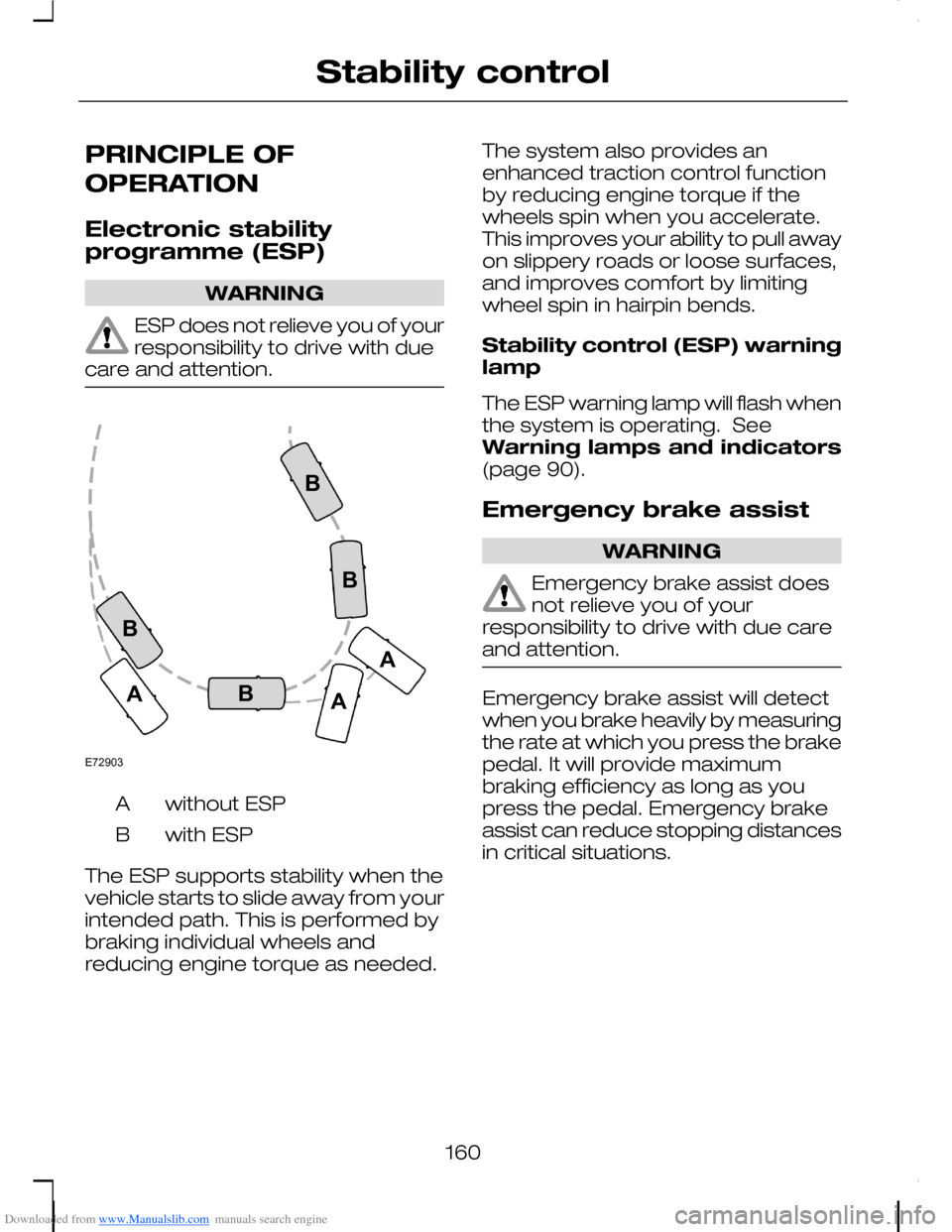
Downloaded from www.Manualslib.com manuals search engine PRINCIPLE OF
OPERATION
Electronic stabilityprogramme (ESP)
WARNING
ESP does not relieve you of yourresponsibility to drive with duecare and attention.
without ESPA
with ESPB
The ESP supports stability when thevehicle starts to slide away from yourintended path. This is performed bybraking individual wheels andreducing engine torque as needed.
The system also provides anenhanced traction control functionby reducing engine torque if thewheels spin when you accelerate.This improves your ability to pull awayon slippery roads or loose surfaces,and improves comfort by limitingwheel spin in hairpin bends.
Stability control (ESP) warninglamp
The ESP warning lamp will flash whenthe system is operating. SeeWarning lamps and indicators(page 90).
Emergency brake assist
WARNING
Emergency brake assist doesnot relieve you of yourresponsibility to drive with due careand attention.
Emergency brake assist will detectwhen you brake heavily by measuringthe rate at which you press the brakepedal. It will provide maximumbraking efficiency as long as youpress the pedal. Emergency brakeassist can reduce stopping distancesin critical situations.
160
Stability controlE72903AAABBBB
Page 166 of 278
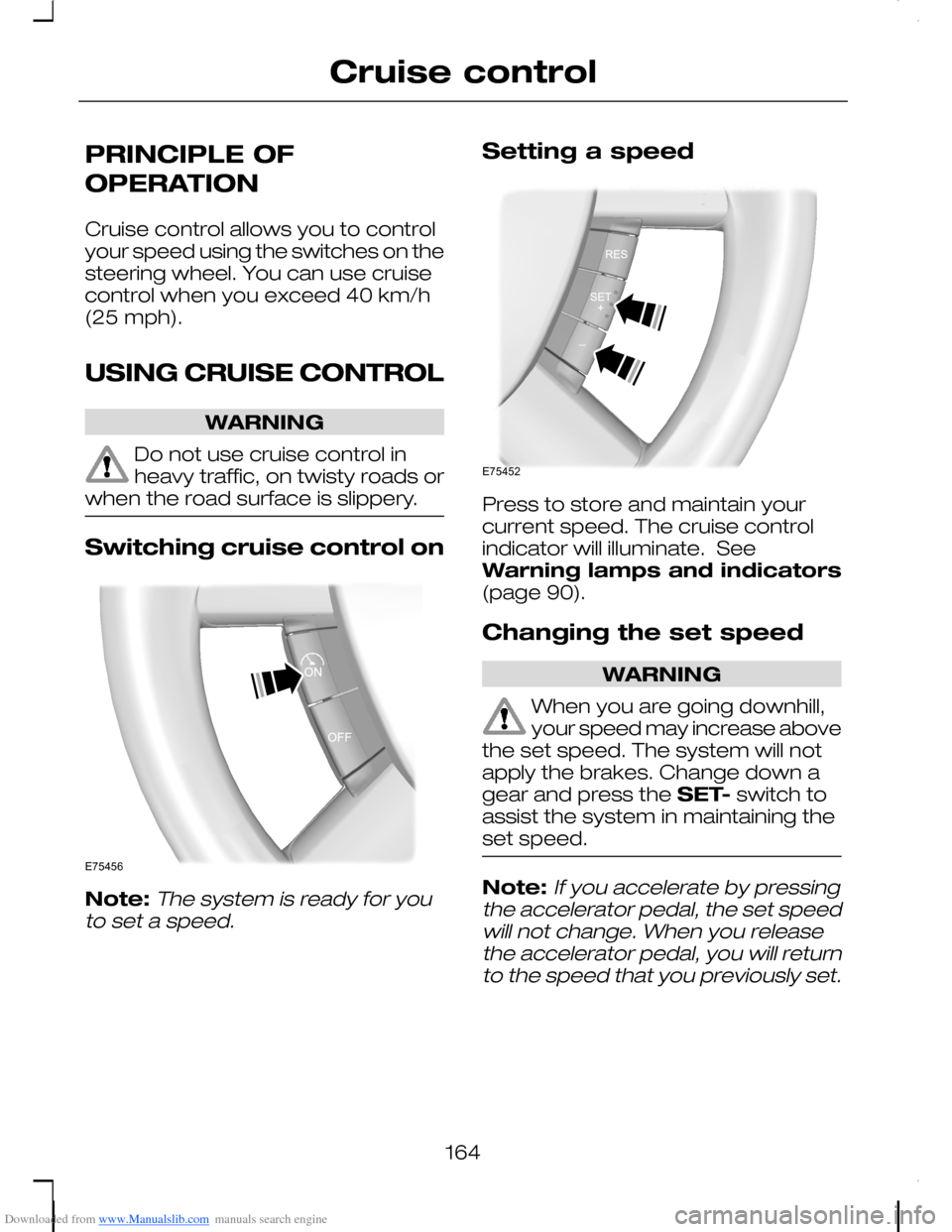
Downloaded from www.Manualslib.com manuals search engine PRINCIPLE OF
OPERATION
Cruise control allows you to controlyour speed using the switches on thesteering wheel. You can use cruisecontrol when you exceed 40 km/h(25 mph).
USING CRUISE CONTROL
WARNING
Do not use cruise control inheavy traffic, on twisty roads orwhen the road surface is slippery.
Switching cruise control on
Note:The system is ready for youto set a speed.
Setting a speed
Press to store and maintain yourcurrent speed. The cruise controlindicator will illuminate. SeeWarning lamps and indicators(page 90).
Changing the set speed
WARNING
When you are going downhill,your speed may increase abovethe set speed. The system will notapply the brakes. Change down agear and press the SET- switch toassist the system in maintaining theset speed.
Note:If you accelerate by pressingthe accelerator pedal, the set speedwill not change. When you releasethe accelerator pedal, you will returnto the speed that you previously set.
164
Cruise controlE75456 E75452
Page 172 of 278
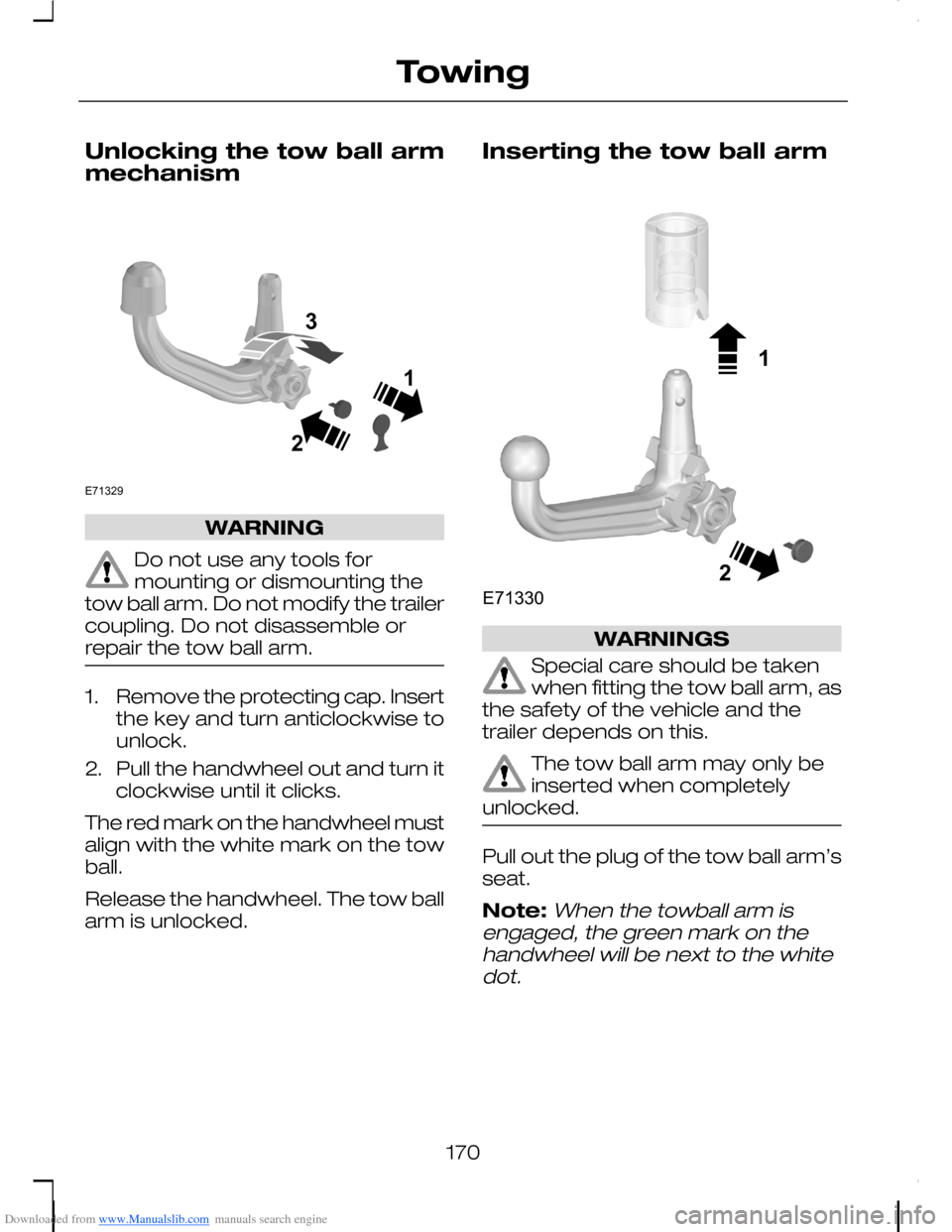
Downloaded from www.Manualslib.com manuals search engine Unlocking the tow ball armmechanism
WARNING
Do not use any tools formounting or dismounting thetow ball arm. Do not modify the trailercoupling. Do not disassemble orrepair the tow ball arm.
1.Remove the protecting cap. Insertthe key and turn anticlockwise tounlock.
2.Pull the handwheel out and turn itclockwise until it clicks.
The red mark on the handwheel mustalign with the white mark on the towball.
Release the handwheel. The tow ballarm is unlocked.
Inserting the tow ball arm
WARNINGS
Special care should be takenwhen fitting the tow ball arm, asthe safety of the vehicle and thetrailer depends on this.
The tow ball arm may only beinserted when completelyunlocked.
Pull out the plug of the tow ball arm’sseat.
Note:When the towball arm isengaged, the green mark on thehandwheel will be next to the whitedot.
170
TowingE71329213 12E71330